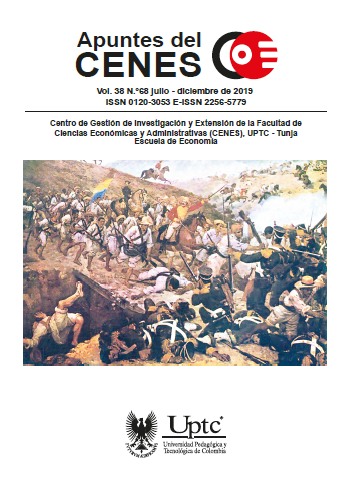Increased Crime and Decreased Labour Participation in the Income in Mexico

Abstract
The growth of crime and the decline of wage share are two trends that have characterized the Mexican economy since the late seventies until the present. However, in the economy research, the causes of these trends are studied in a separated way. In contrast, in this paper is proposed a model of efficiency wages in framework of demand-constrained equilibrium, finding that the growth in the crime supply and the decrease of wage share have a common cause: the diminution of the opportunities for workers to insert themselves and remain employed in the labor market.
Keywords
distribution of income, crime, unemployment, wages, labour market
References
Altindag, D. (2012). Crime and Unemployment: Evidence from Europe. International Review of Law and Economics, 32(1), 145-157. https://doi.org/10.1016/j.irle.2011.10.003
Argandoña, A., Gámez, C. & Mochón, F. (1995). Macroeconomía avanzada I. Modelos dinámicos y teoría de la política económica. Madrid: McGraw-Hill.
Becker, G.S. (1968). Crime and Punishment: An Economic Approach. Journal of Political Economy, 76(2), 1-55. Retrieved from https://olis.leg.state.or.us/liz/2017R1/Downloads/CommitteeMeetingDocument/125036
CSI. (2017) Índice global de los derechos de la CSI 2017. Los peores países del mundo para los trabajadores y las trabajadoras. Bruselas: Confederación Sindical Internacional. Recuperado de https://www.ituc-csi.org/indice-global-de-los-derechos-2017?lang=en
Ehrlich, I. (1973). Participation in Illegitimate Activities: Theoretical and Empirical Investigation. Journal of Political Economy, 81(3), 145-157. Retrieved from https://www.journals.uchicago.edu/doi/10.1086/260058
Enamorado, T. & Winkler, H. (2016). Income Inequality and Violent Crime: Evidence from Mexico´s Drug War. Journal of Development Economics, 120, 128-143. https://doi.org/10.1016/j.jdeveco.2015.12.004
Hein, E. (2017). Post-Keynesian Macroeconomics since the Mid-1990s- Main Development. European Journal of Economics and Economic Police: Intervention, 14(2), 131-172. https://doi.org/10.4337/ejeep.2017.02.01
ILO (2011). Making Markets Work for Jobs. World of Work Report 2011. Retrieved from https://www.ilo.org/wcmsp5/groups/public/@dgreports/@dcomm/@publ/documents/publication/wcms_166021.pdf
ILO & OECD (2015). The Labour Share in G20 Economies. In Report Prepared for the G20 Employment Working Group Antalya, Turkey, 26-27 february 2015. Retrieved from https://www.oecd.org/g20/topics/employment-and-social-policy/The-Labour-Share-in-G20-Economies.pdf
IMF. (2007). The Globalization of Labor. In IMF (Ed.). World Economic Outlook: Spillovers and Cycles in the Global Economy. Washington D. C.: IMF. Retrieved from file:///C:/Users/84861%20HP_ODM002/AppData/Local/Packages/Microsoft.MicrosoftEdge_8wekyb3d8bbwe/TempState/Downloads/_textpdf%20(1).pdf
INEGI. (2017). Encuesta nacional de victimización y percepción sobre seguridad pública (ENVIPE) 2017. México: INEGI. Recuperado de https://www.inegi.org.mx/programas/envipe/2017/
Kahhat, J. (2011). La desigualdad de los ingresos laborales. La demanda y oferta de competencias. En L. López-
Calva & N. Lusting (Ed.) La disminución de la desigualdad en la América Latina (pp. 43-62). México: Fondo de Cultura Económica.
Kelly, M. (2006). Inequality and Crime. Review of Economics and Statistics, 82(4), 530-539. https://doi.org/10.1162/003465300559028
Liu, Y., Fullerton, T., M. & Ashby, J. (2013). Assessing the Impacts of Labor Market and Deterrence Variables on Crime Rates in México. Contemporary Economic Policy, 31(4), 669-690. https://doi.org/10.1111/j.1465-7287.2012.00339.x
Luyando, C. & Herrera J. (2018). Distribución funcional del ingreso y régimen de crecimiento en México y España. Cuadernos de Economía, 37(73), 121-142. https://doi.org/10.15446/cuad.econ.v37n73.58811
Machin, S. & Meghir, C. (2004). Crime and Economic Incentives. The Journal of Human Resource, 39(4), 958-979. https://doi.org/10.3368/jhr.XXXIX.4.958
Mauro, L. & Carmeci, G. (2007). A Poverty Trap of Crime and Unemployment. Review of Development Economics, 11(3), 450-462. https://doi.org/10.1111/j.1467-9361.2006.00350.x
Noriega, F. A. (1997). Teoría del desempleo y la distribución. Evidencia empírica: México 1984-1994. Investigación Económica, 57(22), 143-185. Recuperado de https://www.jstor.org/stable/42842382?seq=1#page_scan_tab_contents
Noriega, F. A. (2001). Macroeconomía para el desarrollo: teoría de la inexistencia del mercado de trabajo. México: MC Graw-Hill.
Piccato, P., Hidalgo, S. & Lajous, A. (2018). Estadísticas del crimen en México: series históricas 1926-2008. Recuperado de https://ppiccato.shinyapps.io/judiciales/
Ramírez, M. (2011) Los sindicatos blancos en Monterrey. Frontera Norte, 23(46), 177-210. http://dx.doi.org/10.17428/rfn.v23i46.828
Samaniego, N. (2014) La participación del trabajo en el ingreso nacional: el regreso a un tema olvidado. Economía Unam, 11(33) 52-77. Recuperado de https://www.sciencedirect.com/science/article/pii/S1665952X14721814
Secretariado Ejecutivo del Sistema Nacional de Seguridad Pública (2018). Instrumento para el Registro, Clasificación y Reporte de los Delitos y las Víctimas CNSP/38/15. Manuel de Llenado. México: Seguridad Secretaria de Seguridad y Protección Ciudadana. Recuperado de https://www.gob.mx/sesnsp/acciones-y-programas/incidencia-delictiva-87005?idiom=es
Shapiro, C. & Stiglitz, J. E. (1984). Equilibrium Unemployment as a Worker Discipline Device. The American Economic Review, 74(3), 433-444. Retrieved from http://kisi.deu.edu.tr/yesim.kustepeli/shapiro1984.pdf
Solow, R. M. (1979). Another Possible Source of Wage Stickiness. Journal of Macroeconomics, 1(1), 79-82. https://doi.org/10.1016/0164-0704(79)90022-3
Stockhammer, E. (2013). Why Have Wage Shares Fallen? A Panel Analysis of Determinants of Functional Income Distribution. OIL Condition of Work and Employment Series, 35, 1-52. Retrieved from https://www.ilo.org/public/libdoc/ilo/2013/470913.pdf
Vargas, J. R. (2017). Trabajo especializado y diferencial salarial. Análisis Económico, 32(80), 27-44. Recuperado de https://www.redalyc.org/html/413/41352782003/
Velázquez, D. & Hernández, Z. S. (2018). Una explicación a la curva de salarios. Cuadernos de Economía, 37(73), 67-94. https://doi.org/10.15446/cuad.econ.v37n73.54225
Velázquez, D. & Rodríguez, E. (2016). Una explicación a la relación procíclica y antícíclica de los salarios ante el empleo. Equilibrio Económico, 12(2), 125-160. Recuperado de http://www.equilibrioeconomico.uadec.mx/descargas/Rev2016/Rev16Sem2Art1.pdf
Yamada, T. (1985). The Crime Rate and the Condition of the Labor Market: A Vector Autoregressive Model. NBER Working Paper, (1782), 1-18. Retrieved from https://www.nber.org/papers/w1782.pdf
Yamada, T., Yamada, T. & Kang, M. (1991). Crime Rates versus Labor Market Conditions: Theory and Time-Series Evidence. NBER Working Paper, (3801), 1-26. Retrieved from https://www.researchgate.net/profile/Tetsuji_Yamada/publication/5191776_Crime_Rates_Versus_Labor_Market_Conditions_Theory_and_Time-Series_Evidence/links/0912f5091cde9c6cf1000000.pdf
